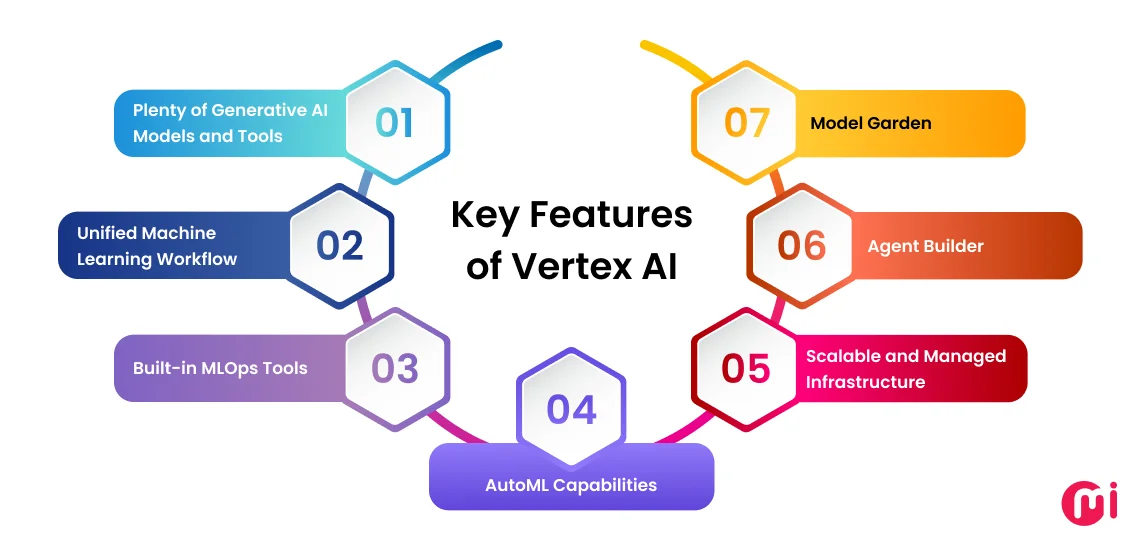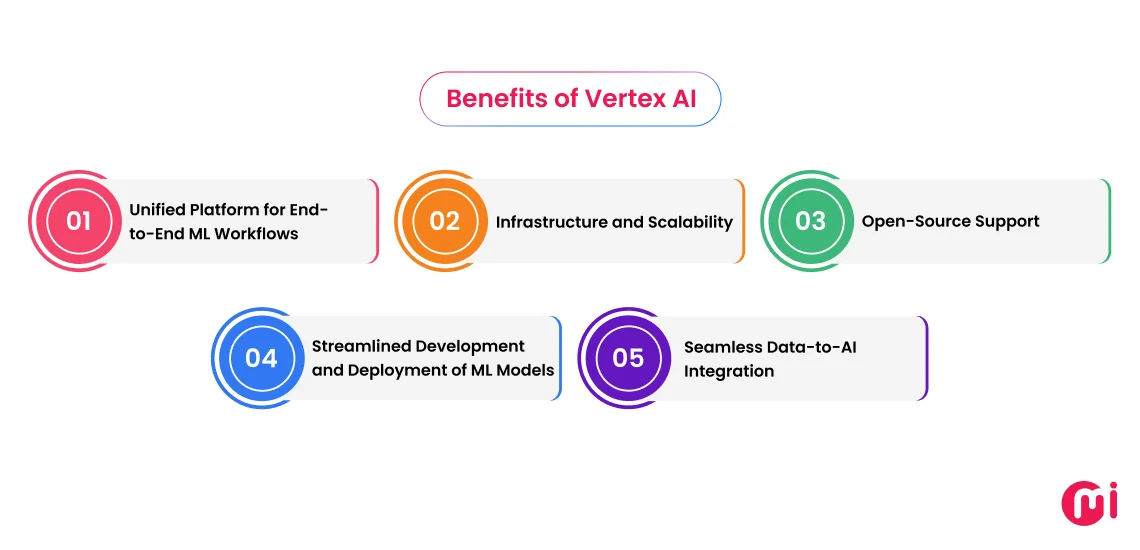What if there were a platform that could help your business accelerate AI innovation, regardless of whether your team consists of novices or AI experts? Google launched Vertex AI with this very goal in mind. To simplify it for you, we’ve curated this blog post to walk you through what Vertex AI is, its features, how it works, use cases, and more.
AI is now the new normal for businesses, driving operational transformation. From improving customer experiences to automating operations and making smarter decisions, AI integration and ML development services are what companies across industries are turning to in order to stay competitive.
But building and scaling AI solutions can be complex, costly, and time-consuming.
That’s where Vertex AI comes in.
In this blog, we’ll explore what Google Vertex AI is, Vertex AI architecture features, real-world use cases, and how it can help your business harness the power of AI with confidence.


What is Vertex AI?
Vertex AI is a unified machine learning (ML) platform that enables you to train, deploy, and scale ML models, as well as customize large language models (LLMs) for your AI solutions. It’s a fully managed AI development environment designed to help you build and leverage both generative AI and traditional AI solutions seamlessly.
Owned by Google Cloud, Vertex AI integrates deeply with Google Cloud infrastructure, making it highly efficient for ML developers for hire to train and deploy ML models at scale. The platform consolidates all the essential tools needed across the end-to-end ML workflow, helping businesses accelerate their AI initiatives with precision.
Key Features of Vertex AI
From pre-trained models to MLOps tools, Vertex AI brings together everything you need to build, scale, and optimize ML models, all in one place. It isn’t just a platform; it’s a complete ecosystem designed to streamline every stage of your machine learning journey.
Here are some key features of Vertex AI that help you unlock the full potential of this fully managed Google Cloud platform.


Plenty of Generative AI Models and Tools
Gemini, Imagen 3, Chirp, Veo, Anthropic’s Claude model family, Llama, and more—Vertex AI gives you access to over 200 foundation and generative AI models (first-party, third-party, and open-source models).
Businesses collaborating with companies offering generative AI development services can choose the model that fits their use case, customize it as needed, and deploy it without building from scratch. This enables businesses to prototype, fine-tune, and launch powerful AI solutions more efficiently and at scale.
Learn how to create a powerful generative AI solution.
Unified Machine Learning Workflow
Vertex AI provides a fully integrated environment to manage the entire ML lifecycle, including data preparation, model training, evaluation, deployment, and monitoring. This end-to-end workflow ensures seamless collaboration between data scientists, ML engineers, and DevOps teams, accelerating time to production and reducing operational complexity.
Built-in MLOps Tools
Want to implement MLOps in your ML workflow? Vertex AI’s MLOps tools have you covered. These modular tools are designed to integrate seamlessly into your existing systems, making the implementation of MLOps straightforward and efficient.
They support model versioning, experiment tracking/analyzing/visualizing, CI/CD pipelines, automated retraining, and real-time monitoring for issues like training-serving skew and prediction drift. With these capabilities, you can easily manage large-scale AI projects, maintain model performance over time, and ensure regulatory compliance, streamlining your AI operations from development to deployment.
AutoML Capabilities
Vertex AI’s AutoML tools, namely AutoML Vision, AutoML Natural Language, AutoML Tables, and AutoML Forecasting, allow users to automatically build high-performance models without deep ML expertise or the need for model coding.
It handles data preprocessing, model architecture selection, hyperparameter tuning, and evaluation, making it easy for non-experts and domain specialists to create accurate models with minimal effort
Model Garden
The Model Garden offers a curated repository of pre-trained, fine-tunable models and APIs. Users can browse models by domain or task, such as vision, text, code, and multimodal applications. With ready-to-deploy pipelines and comprehensive documentation, the Model Garden speeds up experimentation and innovation across teams.
Agent Builder
Google Cloud Vertex AI includes Agent Builder, a platform that offers the Agent Development Kit (ADK) for building AI-powered multi-agent systems. It supports retrieval-augmented generation (RAG), integrates with external tools like LangChain, and runs on a fully managed environment. This makes it easy for AI development services providers to develop multi-agent experiences for customer service, internal tools, and enterprise automation.
Scalable and Managed Infrastructure
Built on Google Cloud’s secure and scalable infrastructure, Vertex AI automatically handles compute provisioning, autoscaling, and load balancing for training and serving models. This fully managed environment ensures your AI workloads perform reliably and cost-effectively, whether you’re running small experiments or enterprise-grade applications.
How Vertex AI Works?
To better understand how Vertex AI works, let us understand the machine learning workflow that allows us to build, deploy, and scale ML models.
Data Preparation
Upon ingesting the data from various sources, the extracted dataset is cleaned and transformed. The data is split into train, validation, and test sets. These data sets are then stored in GCS or BigQuery for easy access and further data processing. The Vertex AI console also facilitates you to label and annotate the data using it.
Model Training
For training the models, Vertex AI offers two options. You can either opt for AutoML, which lets you pick and train the model without writing any model code. You can also custom-train your model using TensorFlow, PyTorch, or scikit-learn in notebooks or containers. In custom training, you have the freedom to opt for your preferred ML model and more control over your model’s architecture.
Unlike AutoML, in this option, you will have to write the training code and also choose/optimize hyperparameter tuning using custom tuning jobs based on your understanding and output requirements. Once the model is trained, it is to be registered in Vertex AI Model Registry as it is designed to handle the versioning, tracking metadata, and hand-off of the trained model to production.
Model Evaluation and Iteration
Once training is complete, Vertex AI provides tools to evaluate model performance. The model performance metrics, such as precision, recall, and more, are taken into consideration for evaluating the performance of the trained model.
Based on evaluation, the different training runs are compared, and if the results aren’t ideal, Vertex AI supports automated hyperparameter tuning to help optimize your model. All the evaluations are then to be included in the Vertex AI Pipelines workflow.
In case of custom training, you can use Explainable AI to understand more details about how the models that you have trained make predictions, i.e., its decision-making process.
Model Serving
Once the model is evaluated, you can either deploy it to endpoints for model serving or you can also query the undeployed model for batch predictions (batch serving). Using the Vertex AI console, you can create a Vertex AI endpoint/AI endpoint to deploy your model. No endpoint is needed if you are opting for batch predictions. Model serving is basically a process of making a trained model available for processing inputs and returning predictions, either in real-time or in batches.
In the case of online (real-time) predictions, Google Cloud Vertex AI offers pre-built containers and custom containers to define the serving environment. Pre-built containers are easy to use, require no setup, and are common frameworks (e.g., TensorFlow, XGBoost). Custom containers, on the other hand, give you full control over the serving environment by allowing you to build your container with specific runtime, custom code, or special dependencies.
Model Monitoring
Once the model is deployed, its performance is continuously monitored to ensure it is (and keeps) performing as expected. Vertex AI Model Monitoring alerts you when it detects prediction data skew drift from the baseline or performance degradation. This allows you to retrain your model and improve its performance.
Learn how to build an AI model.
Use Cases of Vertex AI
From predictive analytics to generative AI applications, Vertex AI is powering innovation across industries. This unified platform enables businesses to deploy scalable AI ML solutions that drive real impact, whether you’re optimizing supply chains, enhancing customer experiences, or personalizing healthcare.
Here are some impactful use cases of putting Vertex AI to work in the real world:
Healthcare
The healthcare industry is increasingly turning to AI to enhance patient care, streamline operations, and support data-driven clinical decisions. Here are some Vertex AI use cases that help healthcare solutions deliver better outcomes:
- Predictive Health Analytics: Leverage patient data to build models that predict disease progression, readmission risk, or treatment outcomes.
- Clinical Decision Support: Fine-tune large language models to provide evidence-based treatment recommendations and reduce diagnostic errors.
- Operational Forecasting: Use ML to optimize resource planning, reduce patient wait times, and enhance hospital operations.
Learn how AI in healthcare is transforming patient care, diagnostics, and operations.
Retail
Retailers who want to provide their customers with a more personalized, efficient, and data-driven shopping experience can leverage Vertex AI in the following ways. Here are some Vertex AI use cases for retail and e-commerce solutions:
- Personalized Product Recommendations: Train and deploy ML models designed to deliver real-time, tailored product suggestions across e-commerce platforms, increasing conversion rates and customer satisfaction.
- Demand Forecasting: Build and fine-tune scalable time-series forecasting models to accurately predict product demand, optimize inventory levels, and reduce stockouts or overstock.
- Visual Search & Image Recognition: Utilize image recognition models to enable shoppers to search products by uploading images, enhancing discoverability and user experience.
- AI-powered Chatbots and Virtual Shopping Assistants: Create custom shopping assistants or support bots using Vertex AI Agent Builder, enhancing customer service with intelligent responses.
Learn more about all things AI in retail, from top benefits and use cases to implementation steps and more.
Manufacturing
The manufacturing industry is under constant pressure to reduce downtime, maintain high product quality, and boost efficiency. AI in manufacturing is something that is redefining the industry, helping with all of these aspects.
Here are some key Google Cloud Vertex AI use cases that manufacturers can leverage to build scalable, real-time machine learning solutions that drive smarter, faster, and more cost-effective operations:
- Predictive Maintenance: Train and fine-tune ML models to detect anomalies in sensor data, anticipate equipment failures, and schedule proactive maintenance, preventing downtime.
- Supply Chain Optimization: Analyze and leverage logistics and procurement data with ML models to improve delivery efficiency and reduce operational costs.
- Production Process Optimization: Deploy AI models that continuously learn and optimize energy usage, throughput, and machine efficiency.
Learn more about how AI in supply chain management is redefining the industry.
Finance
The financial industry is evolving rapidly, driven by digital transformation, increasing regulatory demands, and the need for real-time decision-making. Vertex AI empowers financial institutions to harness the full potential of AI by enabling the development of finance solutions designed for fraud detection, improving risk modeling, personalizing customer experiences, and automating critical workflows.
Here are some Vertex AI use cases that finance industry decision-makers can take advantage of:
- Fraud Detection: Deploy real-time anomaly detection models to identify fraudulent transactions and safeguard customer accounts.
- Dynamic Credit Scoring: Use AutoML and custom ML pipelines to develop adaptive risk models based on real-time behavioral and transactional data.
- Customer Retention Modeling: Predict churn and personalize offers to retain valuable customers with AI-driven insights.
- AI Chatbots for Banking: Utilize Vertex AI Agent Builder to develop secure, smart conversational agents for 24/7 digital banking support.
Learn how AI in fintech is transforming financial services through automation.


Benefits of Vertex AI
Vertex AI offers a wide range of benefits, from faster machine learning solution development to enterprise-grade security, scalability, flexibility, and access to Google’s proprietary ML models.
Below are some of the key advantages that make Vertex AI a powerful choice for building and operationalizing AI solutions.


Unified Platform for End-to-End ML Workflows
From data preparation, training, and testing to deployment, serving, and monitoring, Vertex AI ensures that businesses can manage and optimize their models seamlessly. It eliminates the need for multiple tools, making it easier for data scientists for hire and developers to build, manage, and scale ML solutions, all within a single interface. It enables you to work on both pre-built and custom ML models.
Infrastructure and Scalability
Vertex AI offers seamless integration with core Google Cloud services such as BigQuery, Dataflow, and Cloud Storage, enabling efficient access, processing, and management of data across the entire machine learning (ML) lifecycle. This deep integration not only accelerates data preparation and model training but also ensures robust, scalable performance in production environments.
With the ability to automatically scale resources based on workload demands, Google Cloud Vertex AI effectively eliminates infrastructure bottlenecks, ensuring optimal model performance from development through deployment.
Hence, you have the flexibility and reliability needed to manage both small-scale experiments and large-scale enterprise deployments.
Open-Source Support
Vertex AI embraces the open-source ecosystem, providing robust support for popular ML frameworks like TensorFlow, PyTorch, scikit-learn, and many others. This allows AI developers for hire and data scientists to work with the tools they are familiar with while still benefiting from the advanced capabilities of Vertex AI.
This open-source support ensures that Vertex AI remains flexible, enabling teams to customize their workflows, experiment with new frameworks, and take full advantage of cutting-edge advancements in the ML space.
Streamlined Development and Deployment of ML Models
One of the standout features of Vertex AI is its ability to streamline the development and deployment process. The platform enables the rapid creation and deployment of ML models, from experimentation to production, with minimal friction.
It provides tools like AutoML, pre-trained models, and custom model creation tools that simplify the development process, allowing even non-experts to build high-quality models.
Once a model is ready, Vertex AI handles deployment, ensuring it is served with low latency and high availability. The platform also includes built-in monitoring and versioning tools, making it easier to track and manage models in production and rapidly iterate as needed. This ease of use and speed enables teams to go from prototype to production faster than ever.
Seamless Data-to-AI Integration
As Vertex integrates seamlessly with Google Cloud’s data services, it provides a smooth pipeline for transforming raw data into actionable insights through AI. It is closely connected with services like BigQuery, Dataflow, and Cloud Storage, allowing data scientists and AI ML engineers to quickly access and process data without the need for complex data pipelines.
This integration accelerates the time-to-value for businesses, enabling them to quickly develop and deploy AI models with access to high-quality, real-time data from various sources.Learn more about how AI and ML in business processes are driving the most sought-after transformations.
Summing Up
In a nutshell, Vertex AI streamlines the entire machine learning workflow by bringing together data preparation, model training, deployment, and MLOps in one unified platform. Designed for both beginners and seasoned professionals, it removes much of the complexity from building and managing ML models.
With features like AutoML, pre-built pipelines, custom model support, and integration with Google Cloud services, Vertex AI empowers teams to accelerate innovation and deliver smarter solutions at scale. Whether you’re automating workflows or fine-tuning state-of-the-art models, Vertex AI offers the tools and scalability needed to turn your data into impactful insights.
FAQs on Vertex AI
It is a tool that cloud developers can use to test, tune, augment, and deploy Google’s generative AI models. It offers developers and data scientists an intuitive interface using which they can access these GenAI models from Model Garden within the studio to facilitate easy and rapid creation of GenAI-powered digital products and apps.
This machine learning platform is used by developers and data scientists to build and train ML models, manage and serve ML models, create AI-powered applications, customize ML pipelines, fine-tune and customize large language models (LLMs), scale AI apps, and more.
Vertex AI Agent Builder is a platform that helps developers create, deploy, and manage AI-powered agents using the Agent Development Kit (ADK). Its key features include the Agent Garden, a suite of Agent Tools (including the Retrieval-Augmented Generation (RAG) Engine, support for external frameworks like LangChain, and more), as well as a fully managed runtime environment known as the Vertex AI Agent Engine.
No, the platform only offers up to $300 in free credits to its users for a free trial. Beyond that, the Vertex AI pricing information mentioned bifurcated charges for training data, predictions, deployment, batch predictions, and more. So, Google Cloud Vertex AI does cost money based on usage of the platform beyond free trial credits. Input tokens cost $0.15 per million tokens, while output tokens cost $0.60 per million tokens. Also, as the community mentions, Vertex AI is more expensive than Google AI Studio as well.
Although both belong to the Google AI ecosystem, they serve different roles and purposes. Vertex AI is a Google Cloud platform designed to help developers and data scientists build, deploy, and optimize machine learning models, both Google-developed models (such as Gemini) and custom large language models. Gemini, on the other hand, is a powerful multimodal model developed by Google DeepMind, designed to handle tasks involving text, images, code, and more.
It is a large ML model that trains from multiple modalities or types of data, including text, images, audio, and videos, and generates the output in multiple modalities or types of data, including text, images, audio, and videos. For instance, you prompt these models to generate a caption for any image that you attach in the prompt from your recent vacation for your social media handles.
No, Vertex AI is not an LLM, but a platform that facilitates businesses in training, evaluating, deploying, serving, and customizing ML models. As part of its broader capabilities, Vertex AI can also be used to create, fine-tune, and deploy LLMs.
Vertex AI itself is not inherently a generative AI, but it provides tools and services that can be used to build and deploy generative AI models. Generative AI refers to AI models that can create new content, such as text, images, or music, based on patterns learned from existing data. Examples of generative AI models include GPT (for text generation) and GANs (for image generation). Within Vertex AI, you can build and deploy generative AI models.






